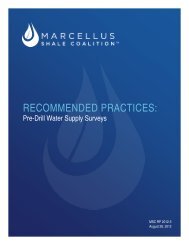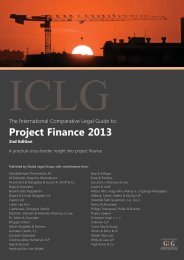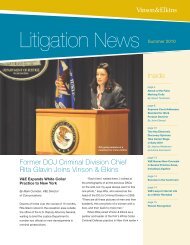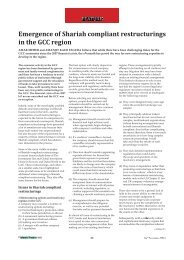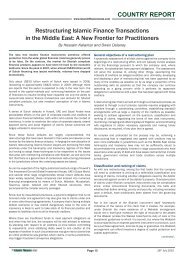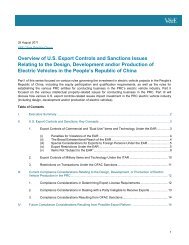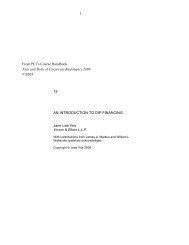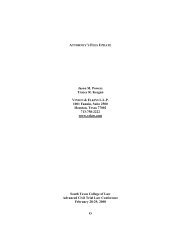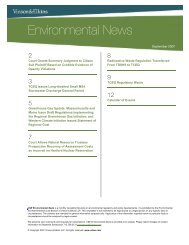TEXAS TRANSNATIONAL LAW QUARTERLY - Vinson & Elkins LLP
TEXAS TRANSNATIONAL LAW QUARTERLY - Vinson & Elkins LLP
TEXAS TRANSNATIONAL LAW QUARTERLY - Vinson & Elkins LLP
Create successful ePaper yourself
Turn your PDF publications into a flip-book with our unique Google optimized e-Paper software.
<strong>TEXAS</strong> <strong>TRANSNATIONAL</strong> <strong>LAW</strong> <strong>QUARTERLY</strong> – June 2009subject to similar GHG regulations. This titlealso contains provisions to promote green jobs;to increase the export of clean energytechnologies; and to help communities andhabitats adapt to the physical impacts of climatechange. Climate change adaption plans arealso mandated for all federal agencies and anew foreign aid program is established toprovide climate adaption assistance to the mostvulnerable developing countries.Title V creates a new program within theDepartment of Agriculture for issuing offsetsbased on domestic agricultural and forestrypractices (e.g., altered tillage practices;reforestation activities). This program is intendedto complement the EPA’s issuance of offsetsrelated to other domestic activities as well asfrom non-U.S. offset projects.This abbreviated guide focuses on Titles III andIV of ACESA, which may be of particular interestto the international lawyer.Title III – Reducing Global Warming PollutionThis title would establish a new long termeconomy-wide program to reduce U.S.emissions of carbon dioxide and six otherGHGs 2 by issuing a steadily declining number oftradable emissions allowances. The stated goalof ACESA is to reduce total GHG emissions by17 percent from 2005 levels by 2020, and justover 80 percent by 2050.The program would be implemented by addingtwo new titles (VII and VIII) to the CAA to beprimarily administered by the EPA. Under theseamendments, each year the owners of fossilfuel-fired electric power plants, major industrialemitters, natural gas utilities, producers andimporters of petroleum-based fuels, and certainother parties are obliged to hold EPA-issuedemissions allowances or equivalent carbonrights. The allowances (and/or offset credits)must be equal in amount to the metric tons ofCO2e that were either (a) emitted in the prioryear or (b) would be released upon combustionof a covered fuel produced or imported in theprior year for sale or distribution in interstatecommerce.The new obligations would be phased in fordifferent covered entities from 2012 to 2016.Entities that emit less than 25,000 metric tons ofCO2e annually would not generally be requiredto hold GHG emissions allowances.Based on the foregoing scheme, the point ofregulation would vary by industry. Emissionsfrom coal and natural gas would be regulateddownstream at or near the point of combustion.Emissions from petroleum-based fuels andnatural gas liquids (NGLs) would be regulatedupstream where the product is first supplied tothe market. Large stationary sources of GHGemissions that are subject to the permitrequirements of the CAA (e.g., because theyemit other regulated pollutants) would also berequired to have a new or amended Title V airpermit. The permit would incorporate the newGHG compliance mandates in the bill and wouldbe predicated upon an advance compliancecommitment by the sources’ owner or operator.To reduce the compliance costs for coveredentities, the program would create a market foremissions allowances and offsets. Once issued,allowances and offsets generally could be freelytraded, and the EPA would be required toregister and track all transfers. Accordingly,entities with excess allowances would be able tosell them to entities whose annual emissionsmay exceed their own store of allowances. Thetotal number of allowances generally woulddecrease by approximately 3 percent each yearand the program contemplates that allowanceprices would rise over time — thus incentivizingreduced emissions. From 2012 to 2020,allowance prices are expected to range between$13 to $26 per ton of CO2.Distribution of Free AllowancesTo provide covered entities and consumers witha period to adjust to the compliance costsassociated with the GHG caps adopted in TitleIII, the bill distributes free allowances for aninitial period to electric and gas utilities,merchant coal generators, energy intensiveindustries, small refiners, state governments,and certain other parties. These freeallowances are typically phased out after 2025.Some allowances are also set aside to supportCCS and other clean energy technologies.Other allowances are to be auctioned to fundvarious U.S. and international climate adaptionprograms.- 14 -




